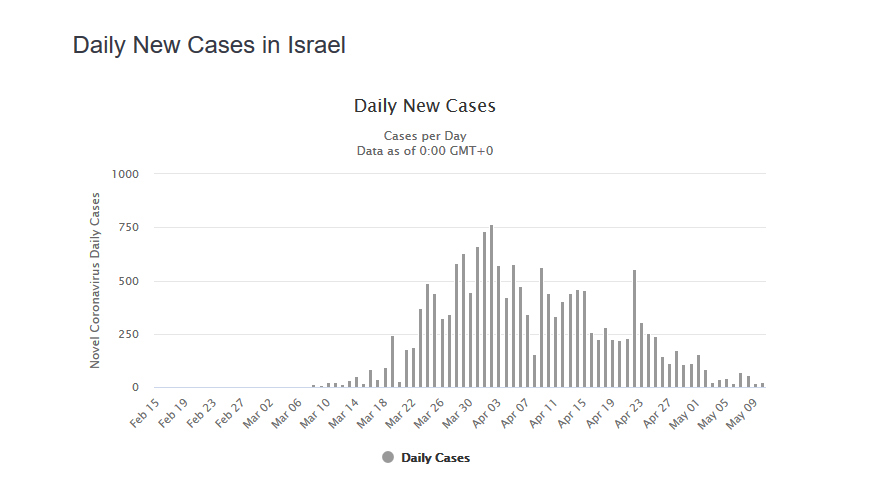Do we really need any more evidence that lockdowns are perhaps the most pernicious snake-oil sold to a panicked citizenry since the Millennium Bug? At least the Millennium Bug panic left behind some upgraded computer systems. The Chinese virus panic seems to bequeath us nothing but ruined economies and generations shattered by despair and isolation.
Several researchers have crunched the numbers and the results keep coming up the same: lockdowns have had little to no effect on the course of the pandemic.
Now, another analysis is telling the same story.
Professor Yitzhak Ben Israel of Tel Aviv University, who also serves on the research and development advisory board for Teva Pharmaceutical Industries, plotted the rates of new coronavirus infections of the U.S., U.K., Sweden, Italy, Israel, Switzerland, France, Germany, and Spain. The numbers told a shocking story: irrespective of whether the country quarantined like Israel, or went about business as usual like Sweden, coronavirus peaked and subsided in the exact same way. In the exact, same, way. His graphs show that all countries experienced seemingly identical coronavirus infection patterns, with the number of infected peaking in the sixth week and rapidly subsiding by the eighth week[…]
“I have no explanation,” he told Mako, “There are is kinds of speculation: maybe it’s climate-related, maybe the virus has its own life cycle.”
“The exact, same, way” is something of an exaggeration. But there does seem to be a roughly similar pattern at work in both lockdown and non-lockdown countries.
It should also be noted that while, yes, Ben Israel is with Teva Pharmaceutical Industries, his primary background is as a military scientist. But, with a PhD in Philosophy and a BSc in Physics and Mathematics, Ben Israel is a logic and numbers kind of guy.
But what about Italy and their staggering 12% mortality rate? “The health system in Italy has its own problems. It has nothing to do with coronavirus. In 2017 it also collapsed because of the flu,” Professor Yitzhak Ben Israel told the news agency. Indeed, Italy’s exceptionally high coronavirus mortality rate is eerily reminiscent of their unusually high flu mortality rates. Supportive of this theory, Germany, has low flu infection and mortality rates and similarly low coronavirus rates.
Ben Israel is also reaching similar conclusions to Wilfred Reilly of KSU in America.
Professor Yitzhak Ben Israel concludes in his analysis summary paper that the data from the past 50 days indicates that the closure policies of the quarantine countries can be replaced by more moderate social distancing policies. The numbers simply do not support quarantine or economic closure.
On the reasonableness of Israel’s unprecedented quarantine and closure, he commented to the news agency, “I think it’s mass hysteria. I have no other way to describe it. 4,500 people die each year from the flu in Israel because of complications, so close the country because of that? No. I don’t see a reason to do it because of a lower-risk epidemic.”
Naturally, Ben Israel’s paper has attracted some fierce criticism. That’s OK, that’s how science works: publish a paper and see how it survives (or not) post-publication. In fact, despite the “progressive” fetish of “peer-review”, post-publication is the real test of scientific credibility. After all, the Wakefield study was peer-reviewed. Suffice to say, it did not survive post-publication.
Another acid test of scientific claims is making predictions and seeing if they happen. Ben Israel confidently predicted “it turns out that the peak of the spread is already behind us for about a week, and it will probably be almost completely wasted in about two weeks”.
That was on the 13th of April. Four weeks later, how does his prediction hold?

Ben Israel may have been a tad overconfident: two weeks later, there were still about 100 daily new cases. But, two weeks after that, Israel’s daily cases have plummeted to almost zero. Critics will, of course, attribute that to lockdown policies. But, as other research has shown, lockdowns have made little difference. Population density, mass public transport and climate seem to be far more influential.
Despite scare-mongering claims, neither does there seem to be any real evidence of the dreaded “second wave”.
If you enjoyed this BFD article please consider sharing it with your friends.










